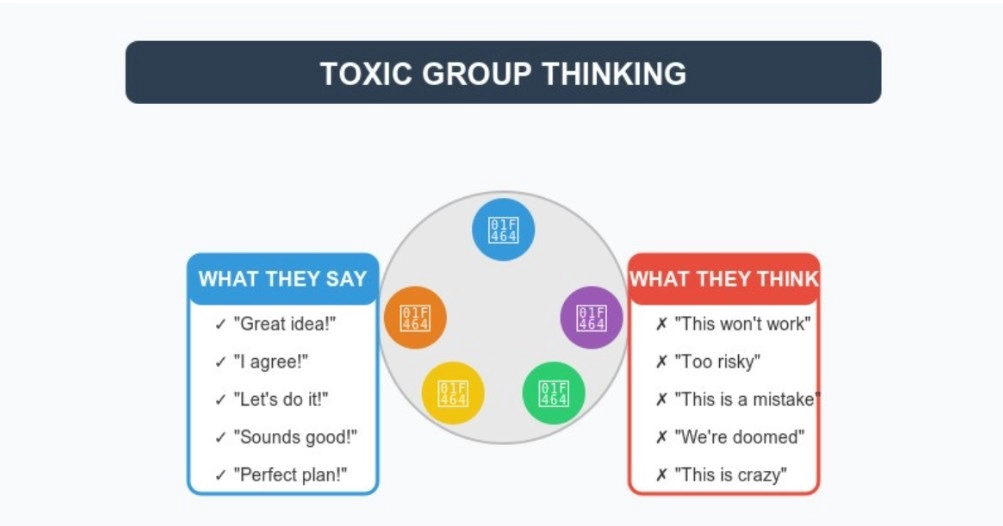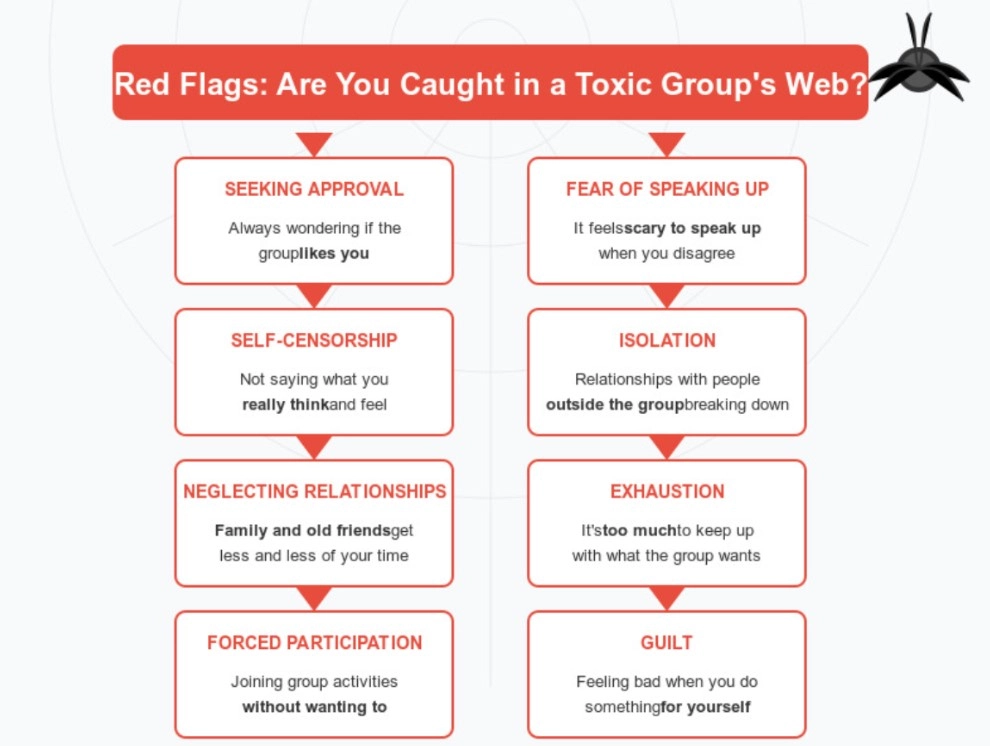Toxic group thinking slowly turns normal teams into places where people feel like they can’t speak freely and where conformity is more important than truth. Holding back your true thoughts, having trouble with relationships outside of work, and always being tired from trying to please everyone are all warning signs.
It takes awareness, recovering your critical thinking skills, and setting up support systems outside of the poisonous environment in order to escape. The best way to leave without making a big deal is to slowly lose value to the group while increasing your freedom. This way, leaving will feel less like an escape and more like going forward.
What is Toxic Group Thinking?
Toxic group thinking happens when teams get trapped in their own inner dialogues. Everyone is nodding along, but they’re all quietly doubting it. In fact, you get a team like this when bossy leaders work with yes-men (Yim & Park, 2021).
- No one is speaking easily because everyone is walking on eggshells.
- The team thinks they’re too big to fail, even though there are clear issues.
- New ideas are shot down before they can grow.
It’s not just bad manners; this messes up choices, stops new ideas from coming up, and makes warm offices very cold. Pelletier found that harmful patterns spread quickly when leaders don’t allow questions.
Just like in the “Don’t Be a Crab” book, where crabs pull down any escape-artist in the bucket, toxic groups drag down their brightest stars. The book really gets it: bad group pressure can keep everyone stuck in bad habits without anyone realizing it.
The red flags are easy to see:
- Your ideas are less important than your job title.
- Acceptance is key—sink or swim with the crowd.
- They hide their mistakes instead of learning from them.
- They treat people with different views like they are aliens.
The real damage, according to Yavaş’s study, is more sick days, ability leaving, and performance going down. Scariest part? When this bad loop starts, teams rarely get back on track without someone who is brave enough to shake things up.
How Is the Behavioral Pattern in These Groups?
These bad habits come on slowly, like a fog, and you don’t even realize you’re in trouble until it’s too late. This often begins with successful teams because early victories conceal the underlying issues.
Here’s what happens in these groups:
| Pattern Type | What It Looks Like | How It Works | Impact on Members |
| Control System | Strict rules, constant watching, threats of punishment | Leaders use fear to keep their power | Members lose their independence and live on edge |
| Group Think | Everyone nods along, debate gets shut down, identical opinions | Forcing everyone to think alike | People stop thinking for themselves |
| Isolation | Cutting outside connections, group-only activities, rejecting outsiders | Keeping members away from outside influence | Members become completely dependent on the group |
| Loyalty Tests | Constant proving, demanding tasks, no questions allowed | Making members demonstrate dedication | Members burn out trying to prove their worth |
| Social Pressure | Group rewards, public shaming, peer enforcement | Using other members to enforce rules | People conform just to avoid punishment |
Red Flags: Are You Caught in a Toxic Group’s Web?
Yim and Park’s research from 2021 and Pelletier’s studies are both eye-opening and show how to tell if you’re caught in a toxic group. Better to know that people usually don’t know they’re being managed until it’s too late, like a frog in water that’s slowly getting hotter.
Your Mind Is No Longer Your Own:
- Always wondering if the group likes you
- It’s scary to speak up when you disagree
- You notice that you’re not saying what you really think and feel
- You keep justifying the group’s misbehavior to yourself and others
- You’re caught between what you want and what the group wants
- It scares you to even consider leaving the group
Your Relationships Are Changing:
- Your relationships with people outside the group are breaking down
- Family and old friends are getting less and less of your time
- The group tells you to cut ties with “negative” people who just don’t agree with them
- People in the group spy on each other and tell leaders about it
- People who question the leaders get in a lot of trouble
Your Personal Life Is Disappearing:
- It’s too much for you to keep up with what the group wants
- You join group activities without wanting to
- Anytime you do something for yourself, you feel bad about it
- Personal gains don’t matter unless they benefit the whole
- You have to do a lot to show your loyalty to the group
How to Escape Toxic Group Thinking?
Now is the time to try these strategies and save yourself from these toxic groups.
Open Your Eyes and Understand What’s Happening
Lipman-Blumen’s study from 2005 says that the first thing you need to do to be free is to see the unseen bands that hold you back. Toxic groups are experts at taking advantage of our basic needs to feel safe and like we belong. As soon as you know how they play, you’re already halfway out the door.
- Know how to tell if someone is love-bombing or guilt-tripping you
- Pay attention to how your emotions change when the group puts pressure on you
- Notice how people who ask questions are treated
- Watch how the group slowly cuts you off from family and friends outside the group.
Find Your Voice Again and Rebuild Critical Thinking
Rose’s study from 2011 shows that your mind is the best weapon you can use to fight group control. If someone has been telling you what to think for too long, you need to use your critical thinking skills again.
- Question group choices (at least in your head)
- Find information from sources the group doesn’t approve
- Keep a secret journal where you can be honest with yourself
- Compare what experts outside the group say with what the group says
- Try to see situations from multiple perspectives, not just the group’s view
Build Your Lifeboat and Get Help from Outside Sources
Later, in 2006, Lipman-Blumen found that you need someone to throw you a rope in order to get out of a hole. When you’re ready to leave the harmful group, having strong ties outside of it can help you both emotionally and in real life.
- Plan regular catch-ups with family (even short video talks!)
- Connect with people in your profession or field
- Attend events where you can meet people with similar interests
- Reach out to old friends and colleagues with active listening (it’s never too late)
- Create a list of people you can call in an emergency
- Develop friendships through hobbies you enjoy
Keep Your Distance (Even While You’re There)
The study by Wen and Guo shows that a good fence is sometimes the best defense. Their research shows that getting away from bad groups mentally helps you think more clearly and feel better, even if you’re still there.
- Separate your work life from your home life
- Choose for yourself first, then ask the group
- Talk to people from different teams or areas
- Take breaks from difficult group situations often
- Join skilled groups outside of your company
- Put things away when you can (for example, work in a different room)
- Watch out for how much you share in events with other people
Clean Up Workplace Toxins
Toxic workplaces cost firms over $200 billion yearly, according to Appelbaum and Roy-Girard‘s shocking findings. How to solve it? Training experts to be “toxin handlers” who can find poison at work and stop it before it spreads to everyone else in the company.
- Teach certain people how to deal with bad events
- Make it easy for people to report bad behavior
- Check the work environment often
- Make step-by-step plans for handling harmful situations with no pushing away people
- Help the people who are working with toxins
- Keep an eye out for trends of bad behavior on different teams
- Set up routes for private feedback
The “Mirror” Method
Reflect the group’s ways of controlling you back to them in a subtle way. When they push you, pull them in ways that are just as hard. This gives everyone a chance to breathe without starting a straight fight.
- Ask nice but critical questions about every request
- When they talk about rules or policies, get everything in writing
- Ask for a full account of choices that are making you confused without being rude
- Look at differences with wide eyes and curiosity instead of criticism
Taking Away Value Strategically
Make yourself less useful to the group one step at a time while you quietly plan your escape. The goal is for you to be the warm coffee they forget about instead of their morning must-have.
- Cut back on your contributions in ways that are clear and acceptable
- Develop a strange unwillingness to take on extra work
- Forget more and more about sharing your special skills or thoughts
- Carefully give other people important tasks by being “helpful.“
The “Grey Rock Plus” Strategy
The Grey Rock Plus trick is similar to the “slightly annoying friend” method for getting people to stop bothering you. Instead of just being dull, you become someone who is annoying enough that people stop inviting you, but not so much that you get in trouble. How to make it work:
- Just get there late enough to be seen (and have a good reason ready!)
- “Forget” about little things now and then (“Oh, that was due today? Sorry!”)
- Get really excited about everything, but mess up the basics anyway
- Do those little things wrong that other people always have to fix
FAQs
How long does it usually take to get out of a bad group?
A clean break takes most people 3 to 6 months. How involved you are with the group and how much money you owe them will determine when you can leave. Most people who are successful don’t make sudden moves; instead, they take things slowly and steadily.
I think my colleague is stuck in a toxic group. How can I help them?
At first, be their friend without any plans and earn their trust before you even say anything about your worries. Don’t talk badly about their group; it will only make them more alert. Instead, ask something nice like, “How do you feel after those meetings?”
I just realized I’m with a bad group of people. What should I do first?
Start by saving your records. Write down all the strange things that are happening, and give yourself some space. A private blog (not on work computers!) is great. Then, give your full trust to one person outside the group. When things get tough, you need someone to help you get back to reality.
My boss is a bad influence. What now?
When your boss is the issue, you need to plan even more! Focus on setting professional limits without drawing attention to yourself. If you can, make friends at your level and above you. Write down the behaviors that are bothering you without using emotional language, and quietly check to see if you can move to a different area.
Can toxic group thinking happen in remote teams too
Oh, definitely! It’s easier to control what people see on remote teams, which can make them even more toxic. Be wary of bosses who constantly check your social media, insist that cameras are always on, expect you to answer at all hours, or punish people who set healthy limits for work hours.
Do certain personality types tend to get stuck in toxic groups more often?”
Anyone can join a harmful group, but people who are naturally good at pleasing other people or who have self-doubt tend to get deeper into the group.









